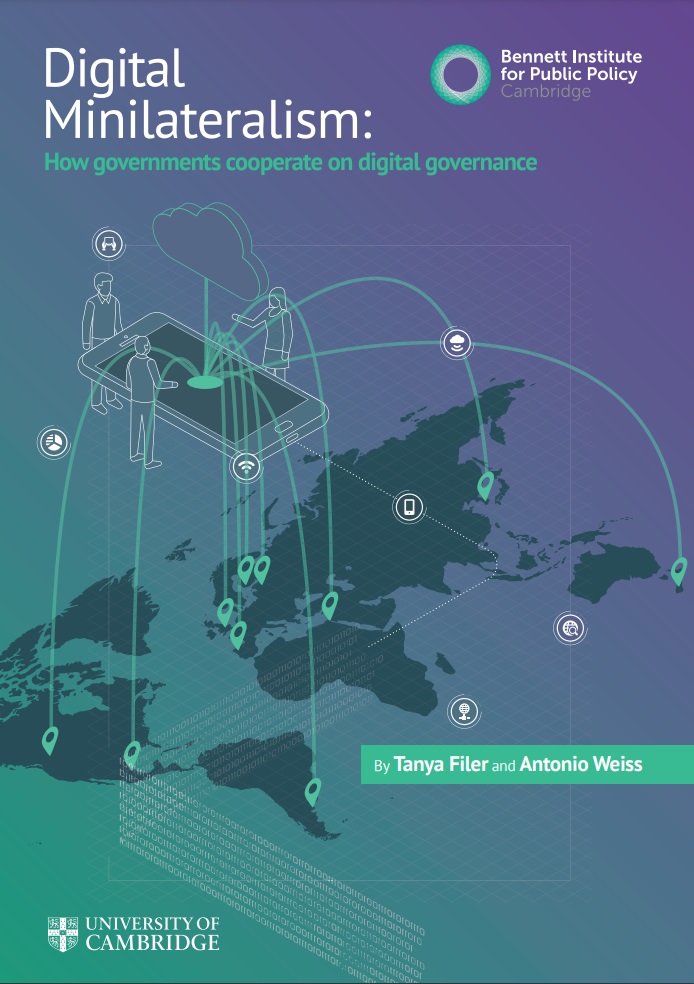The Era of Tech Minilaterals is Here. Will they prove effective?

Tanya Filer examines the rise to prominence of technology “minilaterals”, and considers how their organisational design and governance can set them up for success.
Tech Minilateralism, Rising
Against the backdrop of the UN General Assembly in September last year, the Fall issue of Foreign Policy pointedly declared minilaterals—small cooperative groups of countries—"the alliances that matter now". In a world marked by conflict, complexity and multilateral stagnation, small cooperative networks of countries are burgeoning as models of international cooperation. Jose W. Fernandez, US Undersecretary of State for Economic Growth, Energy, and the Environment, recently enthused about minilaterals as “the way of the future [...] focused, agile, and if we do them right they are going to bring results.” A growing cadre of policymakers agrees.
One prominent area in which countries are turning to minilaterals is technology cooperation, where a need for momentum, peer learning and idea sharing, and robust trade arrangements is key. A 2019 UN report concluded that “existing digital cooperation architecture” is “highly complex and diffused but not necessarily effective”. Its new High-Level Advisory Board on AI reportedly took five years to launch. Amid escalating US-China tech rivalry, some middle powers are also seeking international cooperative mechanisms that allow them to circumvent picking sides.
These concerns are providing tailwinds for minilaterals to address the challenges of an increasingly technology-driven world. I2U2—comprising India, the UAE, Israel, and the US—and 3SI, initially understand as an effort to secure Baltic resilience and buffer against the twin geopolitical forces of Russian expansionism and dependency on the Chinese Belt and Road Initiative (BRI), are technology and infrastructure-focused by design. Technology cooperation is also a growing focal point for prominent cross-thematic groupings. The G7 Leaders’ recent establishment of International Guiding Principles on Artificial Intelligence (AI) is one high-profile example.
Informality and Organisation
In a 2020 report from the University of Cambridge, my co-author Antonio Weiss and I highlighted several characteristics of minilaterals. These forums have tended to be informal, discussion-based, often led by government officials with specialised expertise, and built on individual relationships of trust among their members. This informality grants them perceived advantages such as speed, flexibility, modularity, and room for experimentation, which, we argued, were qualities further enhanced by the use of digital technologies in their modes of work. The low profile Digital Nations (DN) group has showcased the benefits of such characteristics in advancing collective knowhow on digital public services, developing the trust between members required to cooperate on thorny areas of innovation, from digital IDs to responsible implementation of AI within the public sector.
The flipside of this informality is often a little discussed lack of development in the prosaic, technical aspects of minilateral design. Many minilateral groups lack a secretariat or collective budget, posing challenges for decision-making, funding allocation, and institutional memory—how organisations remember what has worked or not before. The G7, a significant gathering of major industrial democracies, lacks a permanent secretariat. The organisational capacity of I2U2 is also limited in governance structure and staffing commitment. 3SI has reportedly struggled to maintain momentum between summits. For minilaterals to foster effective long-term technology cooperation and help nation-states navigate an environment of rapid technological change, they must now address crucial questions and trade-offs regarding organisation, governance, accountability, and global positioning.
 Foundational Design Questions for Technology Minilaterals
Foundational Design Questions for Technology Minilaterals
To be effective, minilaterals must identify an organisational structure that helps to meet their goals—with sufficient flexibility to recognise that collective aspirations may shift over time. If the goal is to be a talking shop for trusted conversations and peer-learning—worthy goals as the need for quick idea sharing during the Covid-19 pandemic proved—ad-hocness, with limited bureaucracy and a set of working groups or yearly themes, is a tried and tested method. Several technology minilaterals operate on an annual summit model. In these instances, regular meetings and projects between summits can help to ensure momentum and sufficient familiarity between participants, at the level of both sherpas and ministers, for the summits to achieve results.
Tech minilaterals like I2U2 and 3SI that aspire to serve as spaces not only of discussion but for building, trading, and investing in digital and physical infrastructure, must prioritise organising and funding shared resources to ensure the longevity that infrastructure projects require. A lack of shared budget can leave minilaterals dependent on individual members that choose to donate resources, and at the whim of changes in domestic leadership among member countries. Long-term operational planning is challenging when dependent upon the financial volunteerism of single member-states. As one former secretariat of a minilateral told me, “without institutionalisation, when leaders change we could just disappear.” Where one country serves as chief funder, the risk of issue-capture also emerges.
Agreeing and structuring the raising and management of a shared budget can be a gnarly cross-border undertaking for a non-legal entity, both legally and operationally. Feasible options range from outsourcing budgetary control and management to setting up an international not-for-profit to manage funds.
A secretariat should be considered a fundraising priority. They can help to provide a central point of contact, and importantly when pursuing cooperative agendas in environments of high turnover, can be a source of collective memory, helping members to remember and learn lessons from strategies that have proven effective or not previously. MIKTA (Mexico, Indonesia, Korea, Turkey, and Australia), an informal group of G20 members that sit outside the more powerful BRICS and G7 is organised by an annually rotating chair, not a stable secretariat. Researchers found that “minilateral arrangements that share MIKTA’s operational characteristics” could prove “short-lived and suffer from weak member commitment, resource constraints, forum-shopping risks, and a leadership vacuum.” Globally, minilateral staffers and observers agree.
As minilaterals grow in influence, and, in some cases, size, they must also consider how they demonstrate accountability to their citizens and the broader global community. An accessible and regularly updated website can help to prevent perceptions of "runaway technocracy", providing elements of transparency and a public face.
How Nations Organise Tech Diplomacy
The effectiveness of minilaterals rests not only on their collective decisions but also on the choices and level of commitment of individual nations. Productive participation requires resource investment. Yet minilaterals often occupy an underlap in how countries organise their foreign affairs, typically neither centrally coordinated nor always clearly designated within individual role descriptions. Furthermore, as a format that fragments foreign policy, it can multiply the commitments of individual civil servants. Rather than attending one conference a year, it is five.
Minilateralism can also ignite tensions between departments. In UK Government, no stranger to technology turf wars, conflicts between the Foreign, Commonwealth and Development Office (FCDO) and other government departments engaged in minilaterals have been observed. A paradox of the perceived collective efficiency that minilateralism can offer to groups of countries is an additional burden on individuals, departments, or on inter-departmental cooperation at the national level.
The challenges of resourcing minilateral participation are more pronounced in smaller economies and nations with limited administrative capacity. Israel's intricate minilateral relationships, for example, have been described as “both intellectually dizzying and practically exhausting.”
Despite these hurdles, it is often “middle powers” that see strategic advantages in technology minilateralism, viewing it as a means to heighten their soft power, through acceptance in a “club” and, as Jordan Storozuk, former secretariat of Digital Nations, described, through the “soft power glow” of other prestigious members rubbing off on them. Policymakers also note the reduced cost of knowledge accumulation in new areas of technological advancement through pooling ideas with friendly nations. Digital Nations has exemplified this peer-to-peer approach to knowledge aggregation on innovative topics that would typically have high start-up costs for individual nations.
As tech minilaterals proliferate, the skill of forum selection, coordination, and participation is likely to become increasingly critical. Policymakers must learn to manage the interplay of a growing range of technology-focused minilaterals within broader domestic and foreign policy. A maturing architecture of tech diplomacy in some countries may aid these efforts. Governments with slimmer institutional capacity need to adopt a particularly targeted approach, making judicious forum selection all the more critical. This will also uplift the contribution they can make to the groups in which they participate.
Technology Minilaterals and Global Cooperation
How minilaterals and their members self-organise could also impact the value that they bring to a broader set of countries beyond their membership alone. Minilaterals could demonstrate their global value through modelling more equitable approaches to international cooperation, promoting varied sources of knowledge and unlocking new flows of information on global challenges.
The technologist Azeem Azhar notes that for “digital minilateralism to close the exponential gap between rich countries and poor, it would need to invite many more players from the developing world to participate.” Minilaterals may also be singularly well placed to expand the range, on some questions, of who from those countries is invited to the table. Researchers at the Atlantic Council note that the digital transformation pillar of 3SI can only fully be legitimised and effective through the engagement of civil society. Similarly, communities living in the most climate-vulnerable settings possess on-the-ground knowledge and lived experiences of severe climate-related impacts, from drought to extreme heat, stories that are rarely heard in international forums. This knowledge is critical to the design and implementation of contextually relevant, effective climate-resilience related technologies, policies, and information provision. Minilateral forums, more intimate and less bound by formal rules of participation than multilateral development banks and other global institutions, are well placed to experiment with effective ways of ensuring that these local perspectives are brought into international debate and decision-making.
As the world grapples with the challenges of an ever-evolving technological landscape, minilaterals are beginning to stand as beacons of innovation and collaboration. Minilateral groups focused on technology trade and governance, and technology-related infrastructure could support cooperation on a wide set of complex international challenges. They could help disentangle aid from terror, including by encouraging technology-based supply chain accountability. They could serve as a lighthouse for responsible AI use that other countries might follow.
Limited bureaucratisation can have advantages, depending on intended outcomes. But for minilaterals to foster effective long-term technology development, investment in their organisational design is imperative. If international cooperation is to produce breakthrough scientific and technological innovations and a global coherence that enables both their regulation and use for public good, we urgently need new organisational innovation in international cooperation too. Sound minilateral design is one part.
Dr. Tanya Filer is affiliated to the Bennett Institute for Public Policy, University of Cambridge, where she established the Digital State project and lectures in public policy. She is Founder and CEO of StateUp.
Photo by Wendy Wei


